Hard rock
| Hard rock | |
|---|---|
| Other names | Heavy rock |
| Stylistic origins |
|
| Other topics | |
Hard rock or heavy rock
The genre developed into a major form of popular music in the 1970s, with the Who, Led Zeppelin and Deep Purple being joined by Black Sabbath, Aerosmith, Kiss, Queen, AC/DC, Thin Lizzy and Van Halen. During the 1980s, some hard rock bands moved away from their hard rock roots and more towards pop rock.[2][3] Established bands made a comeback in the mid-1980s and hard rock reached a commercial peak in the 1980s with glam metal bands such as Mötley Crüe, Bon Jovi and Def Leppard as well as the rawer sounds of Guns N' Roses which followed with great success in the later part of that decade.
Hard rock began losing popularity with the commercial success of R&B, hip-hop, urban pop, grunge and later Britpop in the 1990s. Despite this, many post-grunge bands adopted a hard rock sound and the 2000s saw a renewed interest in established bands, attempts at a revival, and new hard rock bands that emerged from the garage rock and post-punk revival scenes. Out of this movement came garage rock bands like the White Stripes, the Strokes, Interpol and later the Black Keys. In the 2000s, only a few hard rock bands from the 1970s and 1980s managed to sustain highly successful recording careers.
Definitions
Hard rock is a form of loud, aggressive rock music. The electric guitar is often emphasised, used with distortion and other effects, both as a rhythm instrument using repetitive riffs with a varying degree of complexity, and as a solo lead instrument.[5] Drumming characteristically focuses on driving rhythms, strong bass drum and a backbeat on snare, sometimes using cymbals for emphasis.[6] The bass guitar works in conjunction with the drums, occasionally playing riffs, but usually providing a backing for the rhythm and lead guitars.[7] Vocals are often growling, raspy, or involve screaming or wailing, sometimes in a high range, or even falsetto voice.[8]
In the late-1960s, the term
History
The roots of hard rock can be traced back to the mid- to late-1950s, particularly
" (1962).Origins (1960s)
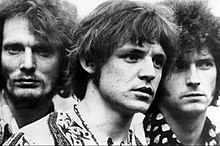
In the 1960s, American and British blues and rock bands began to modify rock and roll by adding harder sounds, heavier guitar riffs, bombastic drumming, and louder vocals, from electric blues.[11] Early forms of hard rock can be heard in the work of Chicago blues musicians Elmore James, Muddy Waters, and Howlin' Wolf,[16] the Kingsmen's version of "Louie Louie" (1963) which made it a garage rock standard,[17] and the songs of rhythm and blues influenced British Invasion acts,[18] including "You Really Got Me" by the Kinks (1964),[19] "My Generation" by the Who (1965)[5] and "(I Can't Get No) Satisfaction" (1965) by the Rolling Stones.[20] Soft rock was often derived from folk rock, using acoustic instruments and putting more emphasis on melody and harmonies.[21] In contrast, hard rock was most often derived from blues rock and was played louder and with more intensity.[5]
Blues rock acts that pioneered the sound included

Groups that emerged from the American psychedelic scene about the same time included Iron Butterfly, MC5, Blue Cheer and Vanilla Fudge.[30] San Francisco band Blue Cheer released a crude and distorted cover of Eddie Cochran's classic "Summertime Blues", from their 1968 debut album Vincebus Eruptum, that outlined much of the later hard rock and heavy metal sound.[30] The same month, Steppenwolf released its self-titled debut album, including "Born to Be Wild", which contained the first lyrical reference to heavy metal and helped popularise the style when it was used in the film Easy Rider (1969).[30] Iron Butterfly's In-A-Gadda-Da-Vida (1968), with its 17-minute-long title track, using organs and with a lengthy drum solo, also prefigured later elements of the sound.[30]
By the end of the decade a distinct genre of hard rock was emerging with bands like Led Zeppelin, who mixed the music of early rock bands with a more hard-edged form of blues rock and acid rock on their first two albums Led Zeppelin (1969) and Led Zeppelin II (1969), and Deep Purple, who began as a progressive rock group in 1968 but achieved their commercial breakthrough with their fourth and distinctively heavier album, Deep Purple in Rock (1970). Also significant was Black Sabbath's Paranoid (1970), which combined guitar riffs with dissonance and more explicit references to the occult and elements of Gothic horror.[31] All three of these bands have been seen as pivotal in the development of heavy metal, but where metal further accentuated the intensity of the music, with bands like Judas Priest following Sabbath's lead into territory that was often "darker and more menacing", hard rock tended to continue to remain the more exuberant, good-time music.[5]
Expansion (1970s)
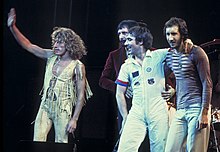
In the early 1970s the Rolling Stones further developed their hard rock sound with
Emerging British acts included

In the United States,
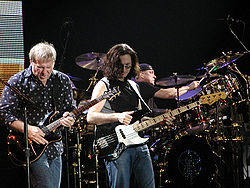
From outside the United Kingdom and the United States, the Canadian trio Rush released three distinctively hard rock albums in 1974–75 (Rush, Fly by Night and Caress of Steel) before moving toward a more progressive sound with the 1976 album 2112.[62][63] Also from Canada, Triumph released their debut album in 1976 before their breakthrough came in the form of the Just a Game album in 1979. Later, the band's streak of popularity continued with the Allied Forces album in 1981. The Irish band Thin Lizzy, which had formed in the late 1960s, made their most substantial commercial breakthrough in 1976 with the hard rock album Jailbreak and their worldwide hit "The Boys Are Back in Town". Their style, consisting of two duelling guitarists often playing leads in harmony, proved itself to be a large influence on later bands. They reached their commercial, and arguably their artistic peak with Black Rose: A Rock Legend (1979).[64] The arrival of the Scorpions from Germany marked the geographical expansion of the subgenre.[31] Australian-formed AC/DC, with a stripped back, riff heavy and abrasive style that also appealed to the punk generation, began to gain international attention from 1976, culminating in the release of their multi-platinum albums Let There Be Rock (1977) and Highway to Hell (1979).[65] Also influenced by a punk ethos were heavy metal bands like Motörhead, while Judas Priest abandoned the remaining elements of the blues in their music,[66] further differentiating the hard rock and heavy metal styles and helping to create the new wave of British heavy metal which was pursued by bands like Iron Maiden, Saxon, and Venom.[67]

With the rise of
Glam metal era (1980s)
The opening years of the 1980s saw a number of changes in personnel and direction of established hard rock acts, including the deaths of
Often categorised with the new wave of British heavy metal, in 1981 Def Leppard released their second album High 'n' Dry, mixing glam-rock with heavy metal, and helping to define the sound of hard rock for the decade.[81] The follow-up Pyromania (1983) was a big hit and the singles "Photograph", "Rock of Ages" and "Foolin'", helped by the emergence of MTV, were successful.[81] It was widely emulated, particularly by the emerging Californian glam metal scene. This was followed by US acts like Mötley Crüe, with their albums Too Fast for Love (1981) and Shout at the Devil (1983) and, as the style grew, the arrival of bands such as Ratt,[82] White Lion,[83] Twisted Sister and Quiet Riot.[84] Quiet Riot's album Metal Health (1983) was the first glam metal album, and arguably the first heavy metal album of any kind, to reach number one in the Billboard music charts and helped open the doors for mainstream success by subsequent bands.[85]
Established bands made something of a comeback in the mid-1980s. After an 8-year separation, Deep Purple returned with the classic Machine Head line-up to produce

Established acts benefited from the new commercial climate, with
Grunge and Britpop (1990s)
Hard rock entered the 1990s as one of the dominant forms of commercial music. The multi-platinum releases of AC/DC's The Razors Edge (1990), Guns N' Roses' Use Your Illusion I and Use Your Illusion II (both in 1991),[101] Ozzy Osbourne's No More Tears (1991),[112] and Van Halen's For Unlawful Carnal Knowledge (1991) showcased this popularity.[72] Additionally, the Black Crowes released their debut album, Shake Your Money Maker (1990), which contained a bluesy classic rock sound and sold five million copies.[113][114] In 1992, Def Leppard followed up 1987's Hysteria with Adrenalize, which went multi-platinum, spawned four Top 40 singles and held the number one spot on the US album chart for five weeks.[115]
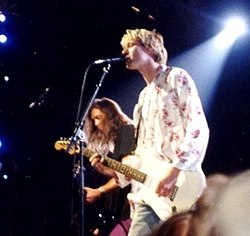
While these few hard rock bands managed to maintain success and popularity in the early part of the decade, alternative forms of hard rock achieved mainstream success in the form of grunge in the US and Britpop in the UK. This was particularly evident after the success of Nirvana's Nevermind (1991), which combined elements of hardcore punk and heavy metal into a "dirty" sound that made use of heavy guitar distortion, fuzz and feedback, along with darker lyrical themes than their "hair band" predecessors.[116][117][118] Although most grunge bands had a sound that sharply contrasted mainstream hard rock, several, including Pearl Jam,[119] Alice in Chains, Mother Love Bone and Soundgarden, were more strongly influenced by 1970s and 1980s rock and metal, while Stone Temple Pilots managed to turn alternative rock into a form of stadium rock.[120][121] However, all grunge bands shunned the macho, anthemic and fashion-focused aesthetics particularly associated with glam metal.[116] In the UK, Oasis were unusual among the Britpop bands of the mid-1990s in incorporating a hard rock sound.[5] Welsh band Manic Street Preachers emerged in 1991 with a sound Stephen Thomas Erlewine proclaimed to be "crunching hard-rock".[122] By 1996, the band enjoyed remarkable vogue throughout much of the world, but were commercially unsuccessful in the U.S.[122]
In the new commercial climate glam metal bands like Europe, Ratt,
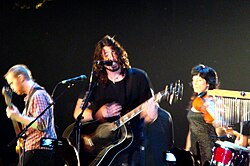
Some established acts continued to enjoy commercial success, such as Aerosmith, with their number one multi-platinum albums:
Survivals and revivals (2000s)

A few hard rock bands from the 1970s and 1980s managed to sustain highly successful recording careers. Bon Jovi were still able to achieve a commercial hit with "It's My Life" from their double platinum-certified album Crush (2000).[102] and AC/DC released the platinum-certified Stiff Upper Lip (2000)[124] Aerosmith released a platinum album, Just Push Play (2001), which saw the band foray further into pop with the hit "Jaded", and a blues cover album, Honkin' on Bobo.[98] Heart achieved their first hit album since the early 90s with Red Velvet Car in 2010,[131] becoming the first female-led hard rock band to earn Top 10 albums spanning five decades. There were reunions and subsequent tours from Van Halen (with Hagar in 2004 and then Roth in 2007),[132] the Who (delayed in 2002 by the death of bassist John Entwistle until 2006)[133] and Black Sabbath (with Osbourne 1997–2006 and Dio 2006–2010)[134] and even a one-off performance by Led Zeppelin (2007),[135] renewing the interest in previous eras. Additionally, hard rock supergroups, such as Audioslave (with former members of Rage Against the Machine and Soundgarden) and Velvet Revolver (with former members of Guns N' Roses, punk band Wasted Youth and Stone Temple Pilots singer Scott Weiland), emerged and experienced some success. However, these bands were short-lived, ending in 2007 and 2008, respectively.[136][137] The long-awaited Guns N' Roses album Chinese Democracy was finally released in 2008, but only went platinum and failed to come close to the success of the band's late 1980s and early 1990s material.[138] More successfully, AC/DC released the double platinum-certified Black Ice (2008).[124] Bon Jovi continued to enjoy success, branching into country music with "Who Says You Can't Go Home", and the rock/country album Lost Highway (2007). In 2009, Bon Jovi released The Circle, which marked a return to their hard rock sound.[102]
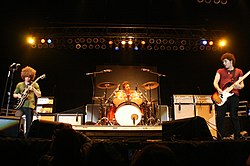
The term "retro-metal" has been applied to such bands as Texas based the Sword, California's High on Fire, Sweden's Witchcraft and Australia's Wolfmother.[139] Wolfmother's self-titled 2005 debut album combined elements of the sounds of Deep Purple and Led Zeppelin.[140] Fellow Australians Airbourne's début album Runnin' Wild (2007) followed in the hard riffing tradition of AC/DC.[141] England's the Darkness' Permission to Land (2003), described as an "eerily realistic simulation of '80s metal and '70s glam",[142] went quintuple platinum in the UK. The follow-up, One Way Ticket to Hell... and Back (2005) was also a hit, but the band broke up in 2006,[143] becoming active again in 2011. Los Angeles band Steel Panther managed to gain a following by sending up 80s glam metal.[144] A more serious attempt to revive glam metal was made by bands of the sleaze metal movement in Sweden, including Vains of Jenna,[145] Hardcore Superstar[146] and Crashdïet.[147]
Although Foo Fighters continued to be one of the most successful rock acts, with albums like
See also
- List of hard rock musicians (A–M)
- List of hard rock musicians (N–Z)
References
- ISBN 978-0-8108-8626-1.
- ^ a b c S. T. Erlewine, "Queen", Allmusic, archived from the original on 12 February 2011.
- ^ ISBN 0-87930-653-X, pp. 903–5.
- Chop'", Strad (0039-2049), 10 January 2006, vol. 117, issue 1398, pp. 72–7.
- ^ a b c d e f g "Hard Rock", Allmusic, archived from the original on 12 February 2011.
- ISBN 0-415-34770-X, pp. 130–1.
- ^ ISBN 0-87930-653-X, pp. 1332–3.
- ISBN 0-19-509887-0, p. 39.
- ISBN 1-904041-70-1, p. 96.
- ISBN 0-8195-6260-2, p. 7.
- ^ a b c Michael Campbell & James Brody (2007), Rock and Roll: An Introduction, page 201
- The Cambridge Companion to Pop and Rock, page 19, Cambridge University Press
- ISBN 0394513223. Retrieved 5 July 2012.
Black country bluesmen made raw, heavily amplified boogie records of their own, especially in Memphis, where guitarists like Joe Hill Louis, Willie Johnson (with the early Howlin' Wolf band) and Pat Hare (with Little Junior Parker) played driving rhythms and scorching, distorted solos that might be counted the distant ancestors of heavy metal.
- ^ ISBN 0-8223-1265-4, pp. 24–27.
- ISBN 1-55652-754-3, p. 559.
- ^ Jane Beethoven, Carman Moore, Rock-It, page 37, Alfred Music
- ^ ISBN 1-84353-105-4, p. 1144.
- ISBN 0-87930-653-X, pp. 1315–6.
- ^ "Review of 'You Really Got Me' ", Denise Sullivan, AllMusic, All Music.com Archived 2020-12-21 at the Wayback Machine
- ISBN 0-7935-4042-9, p. 29.
- ISBN 0-87972-369-6, p. 447.
- ^ R. Unterberger, "Song Review: I Feel Free", AllMusic, retrieved 22 February 2010.
- ISBN 978-0195356625, P. 85.
- ISBN 0-7119-9432-3, p. 112.
- ISBN 0-87930-736-6, pp. 700–2.
- ISBN 0-7935-4042-9, pp. 59–60.
- ISBN 1-59240-064-7.
- ^ a b I. Macdonald, Revolution in the Head: The Beatles Records and the Sixties (London: Vintage, 3rd edn., 2005), p. 298.
- ^ S. T. Erlewine, "Beatles: 'The White Album", AllMusic, retrieved 3 August 2010.
- ^ ISBN 0-8195-6260-2, pp. 9–10.
- ^ ISBN 0-8195-6260-2, p. 10.
- ^ "Exile On Main St. | The Rolling Stones". rollingstones.com. Archived from the original on 2012-10-22. Retrieved 2019-01-19.
- ^ S. T. Erlewine, "Rolling Stones: Exile on Mainstreet", Allmusic, retrieved 3 August 2010.
- ^ "It's Only Rock 'N' Roll – The Rolling Stones | Songs, Reviews, Credits". AllMusic. Retrieved 2019-01-19.
- ^ S. T. Erlewine, "The Rolling Stones", Allmusic, retrieved 3 August 2010.
- ^ "Led Zeppelin III – Led Zeppelin | Songs, Reviews, Credits". AllMusic. Retrieved 2019-01-19.
- ^ "Sold on Song – Song Library – Stairway To Heaven". bbc.co.uk. Retrieved 2019-01-19.
- ^ S. T. Erlewine, "Led Zeppelin", Allmusic, retrieved 27 September 2010.
- ISBN 0-8195-6260-2, p. 64.
- ISBN 0-87930-653-X, pp. 292–3.
- ISBN 1-84449-428-4, p. 52.
- ISBN 0-87930-653-X, pp. 1220–2.
- ^ Paul Rodgers: Biography, iTunes
- ISBN 0-87930-653-X, pp. 52–3.
- ISBN 0-19-509887-0, pp. 138.
- ISBN 0-87930-653-X, pp. 783–4.
- ^ "Queen — Bohemian Rhapsody". Official Charts Company.
- ^ "Alice Cooper". Rock & Roll Hall of Fame. Retrieved 2019-01-19.
- ISBN 0-7385-5236-4, p. 114.
- ISBN 0-87930-653-X, pp. 9–11, 681–2, 794 and 1271–2.
- ^ E. Rivadavia, "Montrose", Allmusic, retrieved 2 August 2010.
- ^ "The Osmonds: how we made Crazy Horses" The Guardian 23 January 2017
- ^ Eddy, Chuck. Stairway to Hell: The Five Hundred Best Heavy Metal Albums in the Universe
- ^ "Toys in the Attic – Aerosmith | Songs, Reviews, Credits". AllMusic. Retrieved 2019-01-19.
- ^ Giles, Jeff (3 May 2016). "That Time Aerosmith Hit Their Stride on 'Rocks'". Ultimate Classic Rock. Retrieved 2019-01-19.
- ^ "The History of BÖC". Blue Oyster Cult.com. Retrieved 2008-09-14.
- ^ a b W. Ruhlmann, "Journey", Allmusic, retrieved 20 June 2010.
- ISBN 0-87930-653-X, p. 132.
- ISBN 0-8131-2310-0, pp. 86–9.
- ^ RIAA Gold and Platinum Search for albums by Ted Nugent
- ISBN 978-1-556-52976-4.
- ^ ISBN 0-87930-653-X, p. 966.
- ^ AllMusic Greg Prato on All the World's a Stage. Retrieved December 14, 2007.
- ISBN 0-87930-653-X, pp. 1333–4.
- ISBN 0-87930-653-X, pp. 3–5.
- ISBN 0-87930-653-X, pp. 605–6.
- ISBN 0-520-25310-8, pp. 146–71.
- ISBN 0-8195-6260-2, p. 11.
- ^ "End of the Century:The Ramones". Independent Lens. PBS. Retrieved 7 November 2009.
- ISBN 0-87930-653-X, pp. 425–6.
- ISBN 0-275-98938-0, p. 51.
- ^ ISBN 0-87930-653-X, pp. 1182–3.
- ISBN 0-19-537371-5, p. 135.
- ^ "Gold & Platinum – Top 100 Albums". RIAA. Archived from the original on 2013-08-16. Retrieved 2009-05-28.
- ISBN 0-87930-653-X, pp. 105–6.
- ISBN 0-87930-653-X, p. 1332.
- ISBN 0-8195-6260-2, pp. 11–14.
- ^ S. T. Erlewine and G. Prato, "Kiss", Allmusic, retrieved 18 September 2010.
- ^ G. Prato, "Kiss: Animalize", Allmusic, retrieved 18 September 2010.
- ISBN 0-646-11917-6.
- ^ ISBN 0-87930-653-X, pp. 293–4.
- ^ a b S. T. Erlewine & G. Prato, "Ratt", Allmusic, retrieved 19 June 2010.
- ^ a b c G. Prato, "White Lion", Allmusic, retrieved 19 June 2010.
- ISBN 0-8147-5748-0, p. 106.
- ^ E. Rivadavia, "Quiet Riot", Allmusic, retrieved 7 July 2010.
- ^ Deep Purple Essential Collection – Planet Rock
- ^ "Heart Discography and Chart Positions". Allmusic.com.
- ISBN 0-87930-653-X, pp. 1271–2.
- ISBN 0-521-55660-0, pp. 100–1.
- ISBN 1-84353-105-4.
- ^ L. Flick, "Bon Jovi bounce back from tragedy", Billboard, Sep 28, 2002, vol. 114, No. 39, ISSN 0006-2510, p. 81.
- ISBN 0-521-45429-8, p. 378.
- ^ "RIAA – Gold & Platinum". RIAA. Archived from the original on 2015-09-08. Retrieved 2008-06-24.
- ^ a b c B. Weber, "Poison", Allmusic, retrieved 19 June 2010.
- ^ a b c W. Ruhlmann, "Cinderella", Allmusic, retrieved 19 June 2010.
- ^ "The Pop Life" – New York Times By Stephen Holden. Published: Wednesday, December 27, 1989. Retrieved October 25, 2009.
- ^ S. T. Erlewine and G. Prato, "Whitesnake", Allmusic, retrieved 27 September 2010.
- ^ a b c d S. T. Erlewine, "Aerosmith", Allmusic, retrieved 27 September 2010.
- ISBN 0-7119-6008-9.
- ^ ISBN 0-87930-653-X, pp. 767–8.
- ^ ISBN 0-87930-653-X, pp. 494–5.
- ^ a b c d S. T. Erlewine, "Bon Jovi", Allmusic, retrieved 20 June 2010.
- ^ "The Billboard 200". Billboard. Nielsen Business Media, Inc. 1988-06-25. Retrieved 2010-03-05.
- ^ "The Billboard 200". Billboard. Nielsen Business Media, Inc. 1988-07-23. Retrieved 2010-03-05.
- ^ "The Billboard 200". Billboard. Nielsen Business Media, Inc. 1988-08-06. Retrieved 2010-03-05.
- ^ "The Billboard 200". Billboard. Nielsen Business Media, Inc. 1988-10-15. Retrieved 2010-03-05.
- ^ S. T. Erlewine, "Extreme", Allmusic, retrieved 10 February 2011.
- ^ S. T. Erlewine, "Warrant", Allmusic, retrieved 10 February 2011.
- ^ S. Huey, "Slaughter", Allmusic, retrieved 10 February 2011.
- ^ S. T. Erlewine, "Firehouse", Allmusic, retrieved 10 February 2011.
- ISBN 0-87930-653-X, pp. 1018–9.
- ^ "RIAA Gold & Platinum database". Recording Industry Association of America. Retrieved 16 February 2009.
- ^ S. T. Erlewine, "The Black Crowes Shake Your Money Maker", Allmusic, retrieved 13 February 2011.
- ^ "RIAA Certifications". Recording Industry Association of America. Retrieved 16 January 2010.
- ^ "Def Leppard – the Band" BBC h2g2, retrieved 18 June 2010.
- ^ a b "Grunge", Allmusic, retrieved 18 June 2010.
- ^ a b "Hair metal", Allmusic, retrieved 14 June 2010.
- ^ ISBN 0-87930-653-X, pp. 1344–7.
- ^ S. T. Erlewine, "Pearl Jam", Allmusic, retrieved 23 June 2010.
- ISBN 1-4234-0567-6, p. 148.
- ^ S. T. Erlewine, "Stone Temple Pilots", Allmusic, retrieved 20 June 2010.
- ^ a b Erlewine, Stephen Thomas. "Manic Street Preachers – Biography & History". AllMusic. Retrieved 12 November 2020.
- ^ S. T. Erlewine and G. Prato, "Guns N' Roses", Allmusic, retrieved 19 June 2010.
- ^ a b c S. T. Erlewine, "AC/DC", Allmusic, retrieved 20 July 2010.
- ^ "the biography of Bon Jovi – singer life story". Retrieved 2013-04-18.
- ^ "Bon Jovi Songs (Top Songs / Chart Singles Discography)". Retrieved 2013-04-18.
- ISBN 0-87930-653-X, pp. 729–30.
- ^ a b "Post-grunge", Allmusic, retrieved 17 January 2010.
- ^ J. Ankeny, "Feeder", Allmusic, retrieved 20 June 2010.
- ^ J. Damas, "Stereophonics: Performance and Cocktails", Allmusic, retrieved 20 June 2010.
- ^ "Heart Discography and Chart Positions". allmusic.com.
- ^ S. T. Erlewine and G. Prato, "Van Halen", Allmusic, retrieved 20 June 2010.
- ^ B. Eder and S. T. Erlewine, "The Who", Allmusic, retrieved 20 June 2010.
- ^ W. Ruhlmann, "Black Sabbath", Allmusic, retrieved 20 June 2010.
- ^ H. MacBain, "Led Zeppelin reunion: the review" New Musical Express, 10 December 2007, retrieved 20 June 2010.
- ^ M. Wilson, "Audioslave", Allmusic, retrieved 20 June 2010.
- ^ J. Loftus, "Velvet Revolver", Allmusic, retrieved 20 June 2010.
- ^ "Gold and Platinum Database Search". Recording Industry Association of America. Archived from the original on 2015-09-08. Retrieved 2009-11-25.
- ^ E. Rivadavia, "The Sword: 'Age of Winters'", Allmusic, retrieved 11 June 2007.
- ^ E. Rivadavia, "'Wolfmother: 'Cosmic Egg'", Allmusic, retrieved 11 June 2007.
- ^ J. Macgregor, "Airbourne", Allmusic, retrieved 19 June 2010.
- ^ H. Phares, The Darkness, Allmusic, retrieved 11 June 2007.
- ^ "Chart Stats: The Darkness", Chart Stats, retrieved 17 June 2008.
- ^ J. Lymangrover, "Steel Panther", Allmusic, retrieved 19 June 2010.
- ^ M. Brown, "Vains of Jenna", Allmusic, retrieved 19 June 2010.
- ^ S. Huey, "Hardcore Superstar", Allmusic, retrieved 19 June 2010.
- ^ K. R. Hoffman, "Crashdïet", Allmusic, retrieved 19 June 2010.
- ^ T. Grierson, "Post-Grunge: A History of Post-Grunge Rock" Archived 2016-05-30 at the Wayback Machine, About.com, retrieved 1 January 2010.
- ^ H. Phares, "Andrew W.K.", Allmusic, retrieved 19 June 2010.
- ^ J. Loftus, "Beautiful Creatures", Allmusic, retrieved 20 June 2010.
- ^ J. Loftus, "Buckcherry", Allmusic, retrieved 19 June 2010.
- ISBN 0-335-20072-9, p. 90.
- ^ J. Ankeny and G. Prato, "Queens of the Stone Age", Allmusic, retrieved 19 June 2010.
- ^ M. Sutton, "Three Days Grace", Allmusic, retrieved 19 June 2010.
- ISBN 1-74059-740-0, p. 58.
- ISBN 1-74104-816-8, p. 52.
- ^ H. Phares, "Them Crooked Vultures", Allmusic, retrieved 2 October 2010.
- ^ "Them Crooked Vultures – Them Crooked Vultures", Acharts.us, retrieved 2 October 2010.
Further reading
- Nicolas Bénard, La culture Hard Rock, Paris, Dilecta, 2008.
- Nicolas Bénard, Métalorama, ethnologie d'une culture contemporaine, 1983–2010, Rosières-en-Haye, Camion Blanc, 2011.
- Fast, Susan (2001). In the Houses of the Holy: Led Zeppelin and the Power of Rock Music. Oxford University Press. ISBN 0-19-511756-5
- Fast, Susan (2005). "Led Zeppelin and the Construction of Masculinity," in Music Cultures in the United States, ed. Ellen Koskoff. Routledge. ISBN 0-415-96588-8
- Guibert, Gérôme, and Fabien Hein (ed.) (2007), "Les Scènes Metal. Sciences sociales et pratiques culturelles radicales", Volume! La revue des musiques populaires, n°5-2, Bordeaux: Éditions Mélanie Seteun. ISBN 978-2-913169-24-1
- Kahn-Harris, Keith, Extreme Metal: Music and Culture on the Edge, Oxford: Berg, 2007, ISBN 1-84520-399-2
- Kahn-Harris, Keith and Fabien Hein (2007), "Metal studies: a bibliography", Volume! La revue des musiques populaires, n°5-2, Bordeaux: Éditions Mélanie Seteun.
- Weinstein, Deena (1991). Heavy Metal: A Cultural Sociology. Lexington. ISBN 0-306-80970-2.
External links
 Media related to hard rock at Wikimedia Commons
Media related to hard rock at Wikimedia Commons
